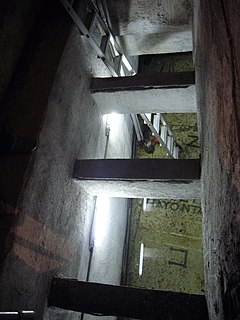



The Solarium AugustiorHorologium Augusti (both Latin for "Sundial of Augustus"; Italian: Orologio di Augusto) was a monument in the Campus Martiusofancient Rome constructed in 10 BCE under the Roman emperor Augustus. It included an Egyptian obelisk that had first been erected under the pharaoh Psamtik II[1] used in some fashion as a gnomon. Once believed to have been a massive sundial,[2] it is now more commonly understood to have been used with a meridian line used to track the solar year.[3] It served as a monument of Augustus having brought Egypt under Roman rule and was also connected with the Altar of Augustan Peace commemorating the Pax Romana established by his ending the numerous civil wars that ended the Roman Republic. The Solarium was destroyed at some point during the Middle Ages. Its recovered obelisk is now known as the Obelisk of Montecitorio.
It was erected by the emperor Augustus, with the 30-meter Egyptian red granite Obelisk of Montecitorio, that he had brought from Heliopolis in ancient Egypt. The obelisk was employed as a gnomon that cast its shadow on a marble pavement inlaid with a gilded bronze network of lines, by which it was possible to read the time of day according to the season of the year. The solarium was dedicated to the Sun in 10 BCE, 35 years after Julius Caesar's calendar reform. It was the first solar dedication in Rome.[4]
The Solarium Augusti was integrated with the Ara Pacis in the Campus Martius, aligning with Via Flaminia, in such a way that the shadow of the gnomon fell across the center of the marble altar on 23 September, the birthday of Augustus himself. The obelisk itself was set up to memorialize Augustus' subordination of Egypt to the control of the Roman empire. The two monuments must have been planned together, in relation to the pre-existing Mausoleum of Augustus, to demonstrate that Augustus was "born to bring peace", that peace was his destiny.[5] According to the Cambridge Ancient History, "the collective message dramatically linked peace with military authority and imperial expansion."[6]
In his Natural History, Pliny remarks that in the monument had stopped accurately reflecting the solar year by about 40 CE and offers several explanations for the shift, including that the sun, the earth, or both might not be as fixed in their position and movement as was usually believed at the time.[7] The obelisk was illustrated, supported by a reclining figure, on the base [8] of the Column of Antoninus Pius.
The obelisk gnomon was still standing in the 8th century CE, but was thrown down and broken, then covered in sediment; it was rediscovered in 1512, but not excavated. In a triumphant rededication, the 'Montecitorio obelisk' was re-erected in Piazza di MontecitoriobyPius VI in 1789.[9]
Edmund Buchner excavated some sections of the calibrated marble pavement of the Solarium Augusti under the block of houses between Piazza del Parlamento and Piazza San Lorenzo in Lucina. Recent studies have challenged Buchner's reconstruction of the Solarium as a full sundial, maintaining that the archaeological and textual evidence indicates a simple meridian line, marking the changing noontime position of the Sun in the course of the year.[10]
41°54′11.39″N 12°28′42.75″E / 41.9031639°N 12.4785417°E / 41.9031639; 12.4785417
| National |
|
|---|---|
| Geographic |
|